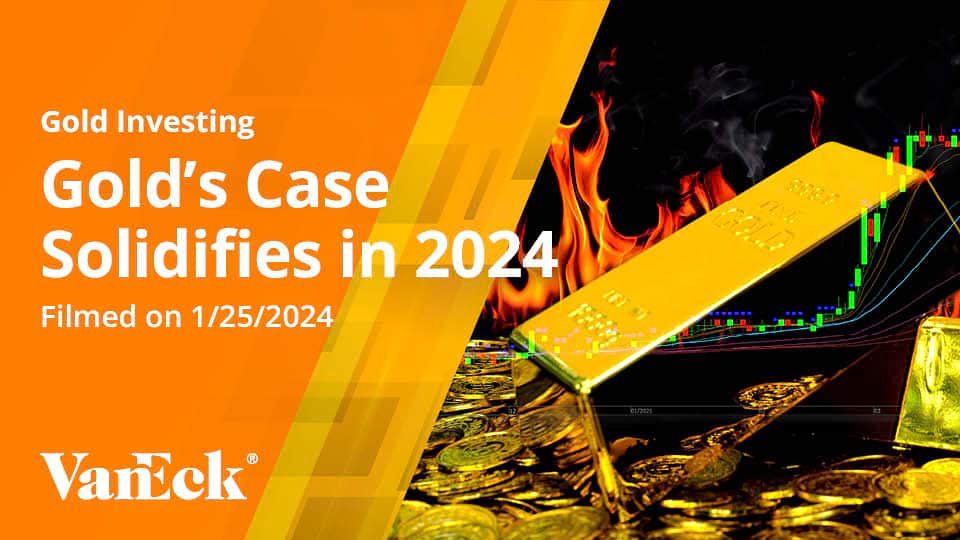Gold Payday on Fed’s Gamble
10 May 2023
Read Time 5 MIN
Monthly gold market and economic insights from Imaru Casanova, Portfolio Manager and Joe Foster, Gold Strategist, featuring their unique views on mining and gold’s portfolio benefits.
Gold Moves Higher Heading Into May
Gold continued its trend higher in April. It reached a yearly high of $2,048 per ounce on April 13, which coincided with the U.S. dollar’s (DXY Index)1 low for the year. It then traded in a tight range at around the $2,000 level, pressured by a bounce back in the U.S. dollar in the second half of April. With the banking crisis “under control”, markets turned their attention to the U.S. Federal Reserve’s (Fed’s) next policy meeting, looking at current economic releases for clues. The monthly releases were quite mixed, maintaining market opaqueness. The Consumer Price Index (CPI)2 reading for March did show inflation declining; however, Core CPI (CPI excluding food and energy items) was up 5.6% from a year ago, above the overall measure, which was up 5%. Meanwhile, the Core Personal Consumption Expenditures (PCE)3 reading, the Fed’s preferred inflation gauge, increased to 4.9% in the first quarter of 2023. Manufacturing and services Purchasing Managers Indexes (PMIs)4 in the U.S. surprised to the upside, while first quarter GDP for 2023 came in at 1.1%, well below expectations of 1.9%. Gold and the U.S. dollar fluctuated as market participants, and members of the Fed, assessed the data and expressed their views on monetary policy outcomes. Gold closed at $1,990 on April 28, a $20.72 per ounce (1.05%) advance for the month.
The NYSE Arca Gold Miners Index (GDMNTR)5 outperformed gold, up 3.63%, while the MVIS Global Juniors Gold Miners Index (MVGDXJTR)6 was up 0.40% during the month of April. The first quarter reporting season of 2023 is off to a good start with gold mining companies so far generally meeting or beating expectations. Gold stocks are outperforming gold this year, following years of underperformance. Consistently meeting expectations is an important driver of what we expect will eventually be a rerating of gold equities. This is supported not only by our outlook of higher gold prices, but also by the companies’ continued commitment to value creation via cost control, disciplined growth and a focus on returns.
Banking Crisis: Contained?
It is likely a bit too early to say whether the banking crisis is contained or over. The collapse and rescue of yet another bank, First Republic Bank, this past weekend, is clear evidence that risks remain. Once again, regulators intervened, and a more catastrophic failure was averted. However, it is another sign of the fragility of the global financial system at present. Even if this was the end of the banking turmoil, which appears unlikely, these recent developments bring to light the significant stress imposed on the economy by higher interest rates and certainly worsen and accelerate the chances of a recession or hard landing. It also makes it very clear that just like the banks, other sectors of the economy may be vulnerable, increasing uncertainty and volatility in the markets. This is supportive of gold prices.
With inflation significantly above the Fed’s target, the Fed is stuck between a rock and a hard place. The fight against inflation is clearly not over, but the Fed may be forced to stop its rate hiking program before another crisis develops somewhere else. Historically (think of the 70s), a stop-and-go approach to fighting elevated inflation has not been successful. Unfortunately, controlling inflation without causing significant damage to the economy may not be possible. A Bloomberg article quoted former treasury secretary Lawrence Summers saying that taming inflation will likely lead to a “meaningful” economic downturn.i Some estimate that the effects of the recent banking crisis may be equivalent to one or two 25 basis points rate hikes by the Fed, suggesting that even if the Fed pauses, worsening credit conditions will slow down the economy and cool inflation. This is speculative, of course, as there is no way to quantify these effects. But it does seem logical that lasting ramifications from banking sector turmoil may continue to impact the economy. “Under control?”, perhaps, “Contained?”, likely not yet.
Fed Pause Benefits Gold
Gold may be in a privileged position at present. A Fed pause raises a flag: the economy is so weak that the Fed is afraid of causing too much damage by increasing rates further; this is gold positive, both because a weak economy sends investors running to gold and because lower rates make gold more attractive to own. The longer-term implications of a Fed pause on inflation expectations could also support gold: will inflation remain elevated? Is there significant risk that it may accelerate again? Gold is considered a hedge against inflation and its historic performance in high inflation periods confirms this role.
Gold Historically Rallies in Periods of High Inflation
Gold nominal and real returns in US dollars as a function of annual inflation*
* As of 31 December 2022. Based on y-o-y changes in US dollars for 'gold': LMBA Gold Price PM and 'inflation': US CPI since January 1971.
Source: World Gold Council, Bloomberg, ICE. Data as of December 31, 2022.
Furthermore, a Fed pause should lead to weakness in the U.S. dollar. The reversal of the strong dollar trend of 2022, we believe, should continue to be an important driver of gold prices in 2023. The U.S. debt ceiling debacle and mentions of a potential technical default as soon as June 1 weigh heavily on the dollar. Needless to say, an actual default would be disastrous. Diversification away from the U.S. dollar and into gold is a topic we have been covering recently in the context of record net purchases of gold by central banks in 2022, with continued strength into 2023. Coverage of the de-dollarization theme has picked up recently. A report by Bank of America highlights research that shows a series of gold technical patterns supporting gold prices in the range of $2,078 all the way to possibly $2,543 per ounce. In that same report, they point to fear of dollar debasement as another driver of gold demand, as other nations look to reduce their reliance on the U.S. dollar by transacting in other currencies.
Everyone is Talking Down the Dollar
Source: BofA ETF Research, Bloomberg.
Global De-Dollarization
Shifting the U.S. dollar’s dominance as the world’s currency to other currencies, if it happens, is obviously something that would take a long time. However, de-dollarization efforts around the world today are without a doubt negative for the U.S. dollar. A weaker dollar alone is supportive of gold prices. In addition, because gold is so underheld, even a small shift in investment away from the U.S. dollar and into gold would lead to significantly higher demand for gold. Gold have been chosen by central banks; others may follow.
i Bloomberg Notes, 4/26/2023, “Summers Says US Inflation Won’t Drop to 2% Without a Downturn,”
1The U.S. Dollar Index (DXY) measures the value of the U.S. dollar relative to a basket of foreign currencies, often referred to as a basket of U.S. trade partners' currencies. 2U.S. Consumer Price Index (CPI) is a measure of the average change in the price for goods and services paid by urban consumers between any two time periods. It can also represent the buying habits of urban consumers. 3Core Personal Consumption Expenditures Index (PCE) is a price index that measures the prices paid by consumers for goods and services without the volatility caused by movements in food and energy prices. 4Purchasing Managers’ Indexes (PMIs) are indices of the prevailing direction of economic trends in the manufacturing and service sectors. It consists of a diffusion index that summarizes whether market conditions, as viewed by purchasing managers, are expanding, staying the same, or contracting. 5NYSE Arca Gold Miners Index (GDMNTR) is a modified market capitalization-weighted index comprised of publicly traded companies involved primarily in the mining for gold. 6MVIS Global Junior Gold Miners Index (MVGDXJTR) is a rules-based, modified market capitalization-weighted, float-adjusted index comprised of a global universe of publicly traded small- and medium-capitalization companies that generate at least 50% of their revenues from gold and/or silver mining, hold real property that has the potential to produce at least 50% of the company’s revenue from gold or silver mining when developed, or primarily invest in gold or silver.
Related Insights
IMPORTANT DEFINITIONS & DISCLOSURES
This material may only be used outside of the United States.
This is not an offer to buy or sell, or a recommendation of any offer to buy or sell any of the securities mentioned herein. Fund holdings will vary. For a complete list of holdings in VanEck Mutual Funds and VanEck ETFs, please visit our website at www.vaneck.com.
The information presented does not involve the rendering of personalized investment, financial, legal, or tax advice. Certain statements contained herein may constitute projections, forecasts and other forward looking statements, which do not reflect actual results. Information provided by third-party sources are believed to be reliable and have not been independently verified for accuracy or completeness and cannot be guaranteed. Any opinions, projections, forecasts, and forward-looking statements presented herein are valid as of the date of this communication and are subject to change without notice. The information herein represents the opinion of the author(s), but not necessarily those of VanEck.
The views contained herein are not to be taken as advice or a recommendation to buy or sell any investment in any jurisdiction, nor is it a commitment from Van Eck Associates Corporation or its subsidiaries to participate in any transactions in any companies mentioned herein. This content is published in the United States. Investors are subject to securities and tax regulations within their applicable jurisdictions that are not addressed herein.
All investing is subject to risk, including the possible loss of the money you invest. As with any investment strategy, there is no guarantee that investment objectives will be met and investors may lose money. Diversification does not ensure a profit or protect against a loss in a declining market. Past performance is no guarantee of future results.

